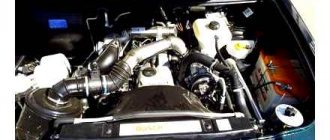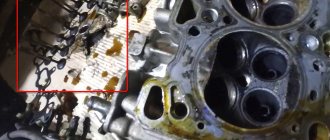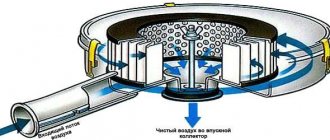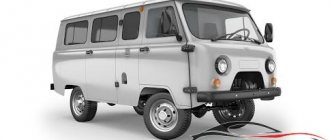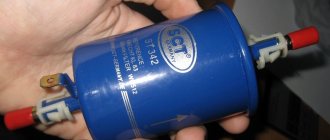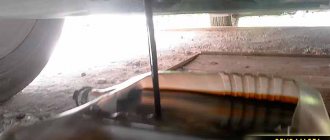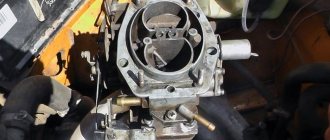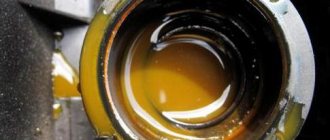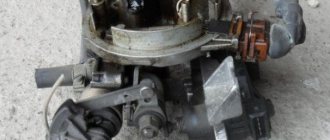Timely replacement air filter ensures normal operation of the internal combustion engine. This applies to internal combustion engines running on both gasoline and diesel fuel. The fact is that in order to burn one liter of fuel, the power unit needs up to 15 liters of atmospheric air (the volume depends on the engine power, the fuel used, including its quality, the condition of the ignition system, etc.). Therefore, the filter must not only do its direct job of cleaning the air, but also not interfere with its entry into the fuel path. It is this fact that is key in determining the need and timeliness of replacing the engine air filter.
This is done mainly according to clear maintenance regulations at intervals of 15...20,000 km. And on your own at home. The only exceptions are new cars that, during the break-in period, undergo technical maintenance exclusively at an official service station.
How often to change the oil filter in a car
To understand how often to change the oil filter in a car, you need to pay attention to the following:
- Engine Features
. Everything matters: what fuel it runs on, what the compression is, engine operating temperature, pressure, friction force of parts - these indicators significantly affect oil contamination. Therefore, in different engines, oil filters are stressed according to their characteristics. Powerful engine? This means you need to change the oil filter often. - Filter element
. It uses a special porous material similar to paper. It is laid in an accordion to increase the filtration area. The better the filter element and the larger its area, the longer the filter will be able to perform its function. As soon as it is completely dirty, the bypass valve will start working, which means it’s time to change the filter. How often this should be done depends on the rate of contamination. - Terms of Use
. One of the most important criteria that determines how often the filter needs to be changed. The change time depends on the mileage of the car, but it is necessary to note the fact that with the same mileage for cars with different purposes, filter wear can vary significantly. Thus, the oil filter of a city car will be much more loaded than that of a car that travels mainly on highways, which means that it may need to be replaced often.
According to the rules, you need to change the filter as often as you change the oil in a car engine. Each brand of car has its own oil service life, but usually it is within 10,000-15,000 km.
But there are times when it is necessary to change the oil filter ahead of time:
- After a major overhaul of a car engine, when the cylinder head (cylinder head) or sump is opened, the filter is changed along with the oil, regardless of whether they have expired or not.
- When the engine lubrication system is washed with a special compound, a temporary filter is installed, preferably a cheap one, since it cannot be used after the procedure is completed. After washing, they install a good quality part for regular work until the next shift.
- Happy owners of cars with powerful engines practice changing the filter ahead of time in order to avoid breakdowns. After all, it’s better to play it safe and spend extra money on a new filter and oil than to pay a considerable amount for repairing an engine with the latest technology.
- If the car has been sitting for a long time. Even if fresh oil was poured into it before downtime, it has an expiration date and loses its lubricating properties, and also releases oxidation products that impregnate the filter materials. Therefore, if you decide to drive a car that has previously been parked for at least a couple of years, be sure to fill the engine with fresh oil and install a new filter.
Types of filters
Modern filters installed on engines differ in design and in the way they purify the air. By design, filters are:
- Panel - like on an injector;
- Ring - like on a carburetor;
- Cylindrical or conical - on racing cars or sports cars (as well as trucks);
They can be classified according to the material of manufacture and the method of purification:
- Made from paper/cardboard. This is by far the most budget-friendly and therefore widespread option. The filter element is porous paper/cardboard, which can trap the smallest dust. Special impregnation allows the paper not to lose its properties when in contact with oil, gasoline or water. The material is folded like an accordion and has many layers to make the usable area larger. Such an element cannot be restored; cleaning and blowing it still will not clear out the dust stuck in the impregnation and stuck in the micron holes. Therefore, after the expiration date, it is simply thrown away.
- Inertial elements. Today, these filters are rarely used, mainly in older car models. Inside the filter housing there is a kind of washcloth made of fishing line. The air flow passing through it is forced to sharply change direction, losing debris in the process. The largest particles will end up at the bottom of the body, while the rest will get stuck inside the washcloth. The filter was simply washed, cleaned, dried and it was ready for use again. In an improved version, a little oil was poured onto the bottom of the housing so that dirt particles would stick to it and the air would be purified better.
- Elements of "Zuleviki". Their design is similar to that of their paper counterparts. Here, instead of paper, multilayer fabric (like gauze) with special impregnation or foam rubber is used. It is many times more expensive than paper ones. This is mainly why it is not used in ordinary cars. They have found application in racing and sports cars due to the least resistance to air flow through them and the best throughput.
- Cylindrical filters are less common and are more common on trucks. The replacement is similar to a regular cardboard element and the composition is mainly cardboard. Blowing, temporary solution, replacement according to deadlines, of course.
Any novice driver can purchase the necessary element. Look under the hood or in the manual that came with the car.
HOW OFTEN SHOULD I CHANGE THE AIR FILTER?
Every driver wonders how long it takes to change the air filter? Unfortunately, it is impossible to give a definite answer. After all, each manufacturer sets its own standards. In addition, it is necessary to take into account the characteristics of the external environment.
If you try to derive a certain pattern, then by replacing it at least once every 10,000 kilometers, you will protect your car from premature wear. In any case, there are a number of signs that will indicate to you that a replacement is needed:
- The car began to consume more fuel.
- Engine power has dropped significantly.
- The amount of CO2 in the exhaust gases has increased.
HOW TO CHANGE THE AIR FILTER?
GENERAL ALGORITHM. Many people are interested in how to replace the air filter; fortunately, this process itself is not particularly difficult. There is a general algorithm that will allow you to quickly make a replacement.
But you must take into account that each car has a unique design. Manufacturers try to do everything possible to achieve maximum efficiency from every part. They experiment with mounting systems, internal design and layout. Therefore, when replacing, each car has its own subtleties.
If we talk about the scheme of action, then we should start by opening the hood. Then you need to find the air filter. In most cases, it is secured with latches. It won't take long to detach them. Next, you will need to assess the condition of the part and, if necessary, replace it.
Sometimes drivers use a vacuum cleaner to prevent contamination or to avoid replacing the air filter. The air flow allows you to slightly clean the clogged element. Unfortunately, such a technique cannot be called extremely effective, but in cases where there are no other options left, it can be used.
In some cases, drivers do not want to replace the air filter. They simply rinse it with water and install it back. Unfortunately, such manipulations are completely useless. After all, this does not help in any way to remove the absorbed dirt.
REPLACING THE AIR FILTER USING THE EXAMPLE OF A KIA RIO CAR
Of course, the general replacement algorithm for all cars is similar. But so that you have a better idea of how this happens, we will carry out this manipulation using the example of a specific car.
In some cases, the element has to be replaced ahead of schedule. Such scrupulousness is acceptable in cases where the part has been damaged or deformed. Moreover, you cannot drive with a faulty filter. This has an extremely negative impact on the performance of the car.
An important sign that a replacement needs to be made is a significant decrease in engine power. If this happens, do not forget to check the device; besides, it will not take much time if you follow this algorithm:
- Unfasten the two spring latches.
- Lift the lid.
- Remove the replacement element.
- Clean the housing from dirt and dust.
- Install a new consumable element.
The process is not particularly complicated. All you need to do is purchase the part and follow the installation instructions.
RESULTS
As you can see, the replacement is not anything overly complicated. It is enough to find the part in the engine compartment, remove the cover, remove the old one and install the new element. Usually these manipulations do not take more than 20 minutes.
Signs it's time to change
I have already described how often replacement is needed, but it happens that it has to be replaced faster when the following signs appear:
- The first is to reduce the amount of air flow from the heating/cooling unit. For example, when they make a lot of noise and are of little use at maximum power.
- The second is the appearance of unpleasant odors during heating/cooling operation, or fogging of the interior windows after they are turned on.
If there are no such signs, it is recommended to check the condition of the element once a year. You can do this yourself without spending money on inviting a specialist. The video shows how to replace the air filter on a VAZ
Replacing filters in a car versus cleaning
Today, every car owner, in a difficult economic situation, is trying to save as much money as possible on owning a car. First of all, the most money spent on maintaining a car is on fuel, insurance and maintenance. Unfortunately, you won’t save much on fuel, since refueling at dubious gas stations with suspiciously cheap fuel is like playing Russian roulette. You also won’t save much on insurance. But nevertheless, every car owner has a real chance to reduce their expenses on repairs and scheduled maintenance of the car. How? I'll tell you now.
Of course, you are unlikely to save money on changing engine oil and other fluids without damaging the car and the engine. Unless, of course, we are talking about windshield washer fluid, which can actually be filled with almost any without fear of damaging anything.
But you can save on the planned replacement of various filters. Yes, yes, despite the fact that you should regularly change the filters in your car - at almost every maintenance, you can extend their service life by simply cleaning them. But remember that you will still have to change all the filters eventually, as temporary cleaning renders them ineffective.
What does it represent?
For high-quality combustion of fuel, it is necessary that the air-fuel mixture contains 15-20 times more air than fuel. Over 100 km of travel, a car consumes about 12-15 cubic meters of air from the surrounding air. As you know, air masses contain dust, dirt, plant seeds and other foreign particles that can enter the engine and act as an abrasive on contacting parts. Thus, this accelerates the wear of parts, which can lead to breakdown of the unit. If air purification is poor, the service life of the motor is reduced several times. Preventing foreign particles from entering the fuel injectors and cylinder walls is the main purpose of the filter element.
Types of consumables
Air filters are divided:
- number of protection stages;
- dust collection principle;
- form.
There are systems with one, two or three levels of protection. The cleaning of inertial dry systems is based on centrifugal force. Air flows in such devices move in a spiral, and foreign particles, due to inertia, settle on the walls of the filter element. Then, depending on the type of product, the particles are either released into the atmosphere or collected in a special bunker. Such filters are used in vehicles operating in dusty conditions: agricultural machinery and trucks. With their help, up to 70% of coarse grain dust is captured.
In an inertial oil filter, the filter element is located in a large cylindrical housing, at the bottom of which oil is poured. The air in this design is purified twice. Entering through the necks and cracks, the air changes direction over the oil. Due to inertia, dust particles settle in the oil. The finest dust remains on an oil-impregnated mesh through which air passes for secondary cleaning. The disadvantage of the filter is the high transmission rate of dust particles up to 1-2%, and at low loads up to 10%. In addition, it requires constant oil changes and washing of the filter element. Currently, they are used only in some old models of Volga, Zaporozhets and trucks.
Inertial oil filter for air
Paper filters are the most widely used. Their filter element is corrugated paper. Due to the fact that the filter element has an accordion shape, the filtration area increases. To prevent the paper from getting wet, it is impregnated with a special resin. Thanks to the structure of paper, air molecules pass through it unhindered, and particles of dust and dirt remain on the fibers.
Paper consumables
Filtering consumables according to their form are divided into:
- panel;
- frameless;
- cylindrical.
Different forms of consumables
In cylindrical ones, a pre-cleaner made of a synthetic substance or special foam rubber can be additionally installed. It traps large dust, extending the service life of the product. The disadvantage of paper filter elements is their short service life and the impossibility of reusable use. Advantages:
- light weight:
- low cost;
- simplicity and ease of replacement.
Zero resistance filters can be installed on sports tuning car models. They are similar to paper ones, but differ in their design. Foam inserts are installed in them as a filter element, this makes it possible to move large volumes of air almost without delay. This way the engine receives a large volume of air in a shorter period of time.
Zero Resistance Air Filter
Classification
Considering how often the engine air filter in a car is changed, it should be said that there are several classifications of these parts. To choose the right one or another, you need to choose the option that is suitable for a particular car.
Filters vary in shape. They can be flat, square, round, etc. Based on the method of filtration, there are direct-flow, inertia-oil, and cyclone filters. Depending on the operating conditions, there may be heavy or ordinary cleaners. Filters also vary in the level of their deterrent capabilities. They can be single or multi-stage.
This diversity is explained by the constant development of technologists in the field of extending the performance characteristics of the car. New views on the problem of ensuring high-quality air purification are constantly emerging. But older car models work with those versions of filters that were developed by the manufacturer at the time the vehicle was produced.
Working principle of the air filter
Basically, for 1 kilogram of fuel, the engine consumes 13-15 kilograms of air, the intake of which occurs outside the vehicle, and also regardless of weather conditions. Because of this, dust, small stones and parts of asphalt, moisture and other substances enter the engine. The filter is designed to clean the air entering the car engine from many harmful impurities.
Engine filter operation diagram
Over time, with intensive use of the car, the air filter may become clogged with particles of dust or substances, which will significantly reduce the throughput and, accordingly, increase the load on the filter itself, which may become deformed.
For normal engine operation, the frequency of replacing the air filter should be twice a year.
.
A few signs of a clogged air filter:
- The car uses more fuel than usual;
- The car lost significant power;
- The level of CO2 in the exhaust is significantly increased.
Most drivers do not attach importance to these facts and “drag out” the problem until the last, critical moment, however, experienced motorists, like the current regulations, confidently declare:
Engine air filter
need to be changed (at least) every six months. Moreover, you can replace it yourself without contacting car services.
Some drivers, in a desire to save an extra penny, pull out and clean the old filter
.
Doing this is strictly prohibited
, since the resource of each filter is limited and, despite its clean appearance, it will not bring any benefit to the car. That is why replacement is the most obvious and relevant option.
The location of the filter depends on the make and model of the car, but the filters themselves are similar, since they are mostly made according to the same principle. How to change the air filter?
Very simple!
How to replace the engine air filter
In cars with an injection engine, the filter is often located in a plastic casing, to which the air intake pipe is connected, and the cover itself is held on by latches. By unhooking them, the car owner has access to the filter, and the procedures for replacing it are similar to those described above. By the way, to change the cabin air filter, you need to carry out almost the same manipulations as with the engine filter. This procedure will take no more than 5-8 minutes on any type of car engine.
Related terms
- Throttle valve
- VKG (crankcase ventilation)
- Intercooler
Air filter Kia Sportage
The manufacturer's recommended service life for the Kia Sportage air filter is 15,000 km, after which it must be replaced with a new one.
Express cleaning of hygroscopic fiber with a stream of compressed air is allowed, provided that the contamination is insignificant. The replacement process is not complicated; the task can be done by a car enthusiast without experience or skills in car maintenance. At the same time, do not forget that unprofessional intervention in repairs leads to negative consequences.
Often, car owners are forced to return to the service station for additional work.
Air filter for Kia Sportage: price, articles, original, quality analogues
Characteristics:
- Weight 947 grams;
- Dimensions: 286 x 165 x 33 mm;
- Filler: paper with hygroscopic fiber, carbon impregnation, depending on the type of filter element.
Modifications of Kia Sportage:
- Sportage JE, KM (from 2004);
- K00 (1994 - 2004);
- QL (from 2015);
- SL (from 2009).
The installation location of the purifier in Kia of the first and second generations is to the left of the radiator, and for the third and fourth generations - on the right, near the headlight.
Article Price in rubles Article Price in rubles
| HENGST FILTER E1044L | From 370 – 420 | MANN-FILTER C 2631 Kia Sportage 3 | From 370 – 420 |
| JAPKO 20H12 Kia Sportage 3 | From 370 – 420 | SAKURA Automotive A-2839 | From 370 – 420 |
| MFILTER K 7061 | From 370 – 420 | STELLOX 7101085SX | From 370 – 420 |
| PATRON PF1598 | From 370 – 420 | COMLINE CHY12255 | From 370 – 420 |
| PURFLUX A1235 | From 370 – 420 | BLUE PRINT ADG02279 | From 370 – 420 |
| KNECHT LX1785 | From 370 – 420 | BOSCH F026400044 | From 370 – 420 |
| ASHIKA 200H012 | From 370 – 420 | FILTRON AP182/9 | From 370 – 420 |
| MEAT & DORIA 18271 | From 370 – 420 | JAPANPARTS FA-H12S | From 370 – 420 |
| UFI 3028000 Kia Sportage 4 | From 370 – 420 | AWM EA1106 Kia Sportage 4 | From 370 – 420 |
| *prices are as of May 2021 |
Characteristic signs of a clogged air filter
- Engine operation is unstable at idle and under load;
- Difficulty starting the engine;
- Sudden loss of power;
- Weak acceleration dynamics;
- The accelerator pedal is unresponsive;
- Increased fuel consumption;
- Shots in the muffler. Which indicates that the combustible mixture is unbalanced.
The list of symptoms is not exhaustive, some of them are characteristic of other breakdowns
At the initial stage, it is important to correctly identify the fault so as not to go down the wrong path
To ensure objectivity of the data, please contact the service center specialists for help. Use craftsmen to a lesser extent; unprofessional intervention in repairs does not guarantee the functionality of the equipment.
Tips for diagnosing the air filter on a Kia Sportage car with your own hands
The order is as follows:
- Turn off the ignition, squeeze the handbrake, open the hood;
- Depending on the year of manufacture of the model, the location of the cleaning element is to the left or right of the radiator of the cooling system. We find a black plastic case with a filter installed inside;
- Unscrew the lid, move it to the side, remove the element;
- We carry out troubleshooting, inspect for damage, dents, cracks;
- We wipe the dust and remove debris from the body cavity;
- We use a vacuum cleaner for additional express cleaning of the element, provided that the contamination is insignificant.
- We put on the cover and screw in the screws.
Common reasons for filter failure
- Service life exceeding the recommended one (15,000 km);
- Manufacturing defect;
- Contact of moisture, condensation, water, motor or transmission oil, or antifreeze on the fiber;
- Mechanical damage to the plastic case;
- Deformation of the base under the influence of high temperatures.
Replacing the air filter on a Kia Sportage
Preparatory stage:
- Phillips head screwdriver;
- Rags;
- New cleaner;
- Rubber band – seal under the housing cover;
- Additional lighting, if necessary for the master.
Step-by-step instruction:
- Turn off the ignition, open the hood;
- We find a plastic case with a cleaning element;
- Unscrew the bolts and remove the cover to remove and change the filter;
- We carry out troubleshooting, wipe the seat, remove dust;
- Place the new cleaner in the “Down Arrow” position;
- We put on the cover and screw the fasteners.
Replacing the air filter yourself is complete. Subsequent maintenance after 15,000 km. Reduce the resource by 3 - 4 thousand km if the machine is often used in special climatic conditions or dusty areas.
Recommendations from service technicians
- Follow maintenance deadlines;
- Buy an original air filter, with factory serial numbers;
- Use the services of certified representatives;
- Require a quality guarantee for work performed.
Types of air filters
Modern protective elements are represented by four main design solutions:
- cylindrical;
- ring;
- panel;
- frameless.
Cylindrical type air filters are installed in large-sized transport models (buses, agricultural machinery, KamAZ family vehicles and special vehicles for road work)
The main difference between such devices and other types is increased throughput, which is very important when the engine is designed for high fuel consumption. A cylindrical filter will last longer if you wrap it in a piece of thick gauze, that is, add a fabric layer.
The ring type of filter element is used in small passenger cars with carburetor engines. Such devices are inferior to cylindrical ones both in size and throughput.
Panel type filters are also used in passenger cars. The devices are a rectangle with seals along the contour. Under the plastic or metal grille there is a cleaning layer of corrugated paper. Compared to annular air filters, panel air filters are more expensive, but last longer and have a higher throughput.
Frameless elements also consist of paper corrugation and seals (foam rubber or rubber), but do without a grid.
The shape of the part is not critical to the effectiveness of its application. It is much more important what material is used to filter the air entering the engine.
In first place in terms of prevalence is cardboard. This is the most accessible and cheapest material that does an excellent job of cleaning the flow from debris and dust.
Synthetic fibers are in second place in terms of frequency of use in air filters. This material is more expensive than cardboard and slightly superior in efficiency. The owner of a car equipped with a cleaning device of this type must carefully observe the timing of replacement of the consumable.
Sports cars use gauze filters: 5–7 layers of fabric impregnated with special oil do an excellent job of purifying the air flow, ensuring uninterrupted engine operation.
The gauze elements of the purification system are characterized by lower initial air resistance. Another advantage of filters of this type is the ability to use them repeatedly (up to 3-4 times) thanks to special oil treatment.
Basic mistakes when replacing
It would seem that installing a new filter is one of the simplest car maintenance procedures. Unfortunately, many even here manage to make a number of mistakes. Let's take a look at the most popular ones below.
The first common mistake is not to try to restore the old filter. The owners begin to wash the filter honeycombs, trying to clean them as much as possible from accumulated dirt. This is strictly prohibited. The reason lies in the behavior of the production materials. For effective cleaning, honeycombs are made of paper. It's easy to guess what will happen to it when water hits the surface. By installing such a filter back, the engine will begin to perform significantly worse. A so-called “lean” occurs when too much air enters the combustion chamber. And it definitely won’t be clean.
The second mistake is ignoring traces of oil. There should be no liquid inside the work area; motor - even more so. The presence of oily traces indicates a problem with the engine lubrication system. If you install a new filter in its original place, it will not last long. After a breakdown, the car must be taken to a service station for repairs. Technicians must check the condition of the engine and what exactly needs to be changed in it to avoid further oil entering the filter area.
The third common mistake is using non-original, and what’s worse, uncertified products. The first option is allowed if the filter is produced by a company that does not work directly with the manufacturer. That is, whose products are not used as standard at the factory. If there is a certificate, it means that the car brand has approved the model for use, but the owner assumes all risks regarding its performance. You should not pay the slightest attention to products without a certificate. The reason is obvious - they will not be able to work as well as licensed products. The use of non-original, uncertified filters will result in rapid engine failure. Moreover, this can happen at any mileage, be it 500 or 25,000 kilometers.
The best air filters for a car
- MANN C 22 117
The protective device, made in Germany, is designed to clean the air flow entering the combustion chamber and to eliminate the possibility of contamination of the fuel mixture with debris, dust, and small insects.Air filters from can be found on many models of European cars. Automobile giants have been working closely with these manufacturers of consumables for a long time.
Micrograde N synthetic material, developed by company specialists, is used as a filter layer. It is much more effective than paper fillers.
- MANN C1858/2
Another model from MANN + HUMMEL protects the internal surface of the combustion chamber from the abrasive effects of sand, dust, insects, thereby increasing the engine life and its smooth operation.Thanks to the use of German consumables, increased fuel consumption is prevented, therefore, material costs for operating the vehicle are reduced.
This air filter is an accordion made of particularly durable breathable material, the edges of which have sealing gaskets.
- AMC Filter HA-8603/8606/8608/8620/8648
The Japanese brand AMC is a subsidiary of Asahi Filter, its main focus is the supply of consumables and spare parts for Asian cars to the CIS countries.High quality products are guaranteed as 70% of parts are produced in Japan, and the remaining 30% in Israel, Malaysia, Italy and the UK.
The model is designed for installation on HONDA cars and motorcycles and meets the requirements of the Japan Auto Parts Association (JAPA) standards.
The filter layer is made in the form of an accordion and is equipped with a sealing gasket along the perimeter, which eliminates the possibility of extraneous inflow of air stream.
Although this model uses modern materials and the production quality is very high, the price for this consumable is lower than for analogues produced under other brands. This allows car owners to save money by getting ideal quality air purification at a budget price.
Functions of an element in the system
For uninterrupted operation of the power plant, a suitable volume of oxygen must be used. By default, 15 kg of air is required to burn 1 liter of gasoline fuel. At the same time, it must meet a number of requirements: have the correct temperature, density, oxygen saturation and purity. Even small particles of dust can negatively affect the assembly and cause wear on new parts.
For smooth operation, the oxygen volume must be maintained.
To eliminate such troubles, air filters are used. They prevent contaminants from passing along with the air flow, and also isolate the engine from water vapor, which can enter the cylinder blocks and cause corrosion.
Under standard loads, the part reduces wear on the power unit by 15-20%, and under complex loads – by 100%.
How to remove the air filter housing. General leadership
Using the example of Ford Focus 2
1). Open the hood.
2). We unscrew the screws securing the air duct going to the filter housing.
3). Using a screwdriver, pressing on the locking clips, disconnect the air duct from the housing.
4). We remove the air duct.
5). We loosen the worm screw of the clamp, which compresses the air supply hose and the air filter housing at the point of their connection.
6). On the air filter housing, disconnect the air duct with the connecting protrusion.
7). We unscrew the worm screw on the clamp securing the air supply hose to the throttle assembly until it loosens.
8). Disconnect the air duct from the mounting lug of the throttle assembly and remove the air duct.
9). Using a screwdriver, lift up the retainer for the electrical connector of the wiring harness and disconnect the electrical connector from the sensor (1.6 R4 16V Duratec Ti-VCT with variable valve timing).
10). Squeezing the hose clamp on both sides, disconnect the hose of the engine crankcase ventilation system from the fitting on the filter housing.
eleven). Remove the air filter housing.
12). We carry out assembly in reverse order.
How to remove the air filter housing on Lada Kalina?
1). As shown in the photo below, unscrew the two bolts securing the housing.
2). Using pliers, disconnect the expander hose, which is secured to a small plastic latch.
3). Disconnect the connector from the mass air flow sensor by pressing the latch from below.
4). Disconnect the plug from the canister purge valve, which is located in the air filter housing.
5). We disconnect the clamp of the injector pipe, which is connected to the mass air flow sensor and remove the pipe, moving it to the side.
6). Unscrew the 4 bolts and remove the cover from the air filter housing.
7). We remove the adsorber from the body, for which we pull it up and remove it from its seat; there are no fasteners there.
8). We unscrew the nut that secures the air intake (located at the top, near the radiator).
9). Remove the third rubber pad (located closer to the battery).
10). Remove the air filter housing.
How to change the air filter: step-by-step instructions
- First you need to apply the handbrake and turn off the engine. If you have a manual transmission, engage first gear. If your car is equipped with an automatic transmission, put the car in “park” mode.
- Then you should open the hood and secure its lid using the lever.
- On some car models, a brake vacuum hose is connected to the filter housing. It should be carefully disconnected.
- Next, you need to remove the air filter cover, usually located on the top of the engine. The cover is most often secured with four or five screws. Therefore, you will need a regular Phillips screwdriver or a socket wrench. Some car models use clips or wing nuts instead of screws.
- Next, you need to remove the old filter element.
- Before installing a new air filter, you must use a damp cloth to remove any dust and dirt that has accumulated there from the housing.
- Next, you should install a new air filter in the housing, as shown in the figure. It is necessary to position it with the wide part up and press it tightly so that there is no gap between the housing and the filter element.
- Then you need to carefully press the filter with the top cover and secure it with screws, nuts or clips.
Recommendations
- It is worth remembering that if the car has been driven recently, some components located under the hood may be hot.
- Whenever you replace the air filter, you should inspect the corrugated hose that connects the throttle body to the filter housing for cracks, tears, and gaps. If there is a crack in the hose, dust enters the car engine.
- After several trips, it is recommended to check the filter element for contamination levels. If dust accumulates on the rubber rim, the filter element was not installed tightly enough.
- On diesel engines, the filter housing is equipped with a special clogging sensor, making it easier to monitor dust levels. After each filter element replacement, the sensor knob must be turned in the direction of the arrow. It is recommended to replace it when the needle reaches half of the scale.
Air filter for UAZ Patriot: characteristics, replacement
An air filter is a device that cleans the air flow entering the engine.
If contaminated air enters the engine, it will interfere with its normal functioning, causing various malfunctions.
To prevent and rid the ZMZ-409 engine of the UAZ Patriot SUV from polluted air, a filter is installed. This material will tell you about the filter, its parameters and the replacement process.
Characteristic
The air filter on the UAZ Patriot 3163 SUV with the ZMZ-409 engine is located in the engine compartment in the radiator area. It is located in a metal case. It is a cylindrical base with a pipe on the top cover. The housing is secured with a steel clamp located at the bottom (some models have two clamps).
The filter housing must be well secured, otherwise it causes an unpleasant ringing sound from the engine compartment. An air filter element manufactured by Livna is installed on the UAZ 3163 SUV with a ZMZ-409 engine.
This filter has catalog number 3160-1109080-12, so when choosing a product, pay attention to this point. There are other manufacturers of these materials, but this one took care not only of quality, but also of compliance with the dimensions of the device
So, the air cleaning element of the ZMZ-409 engine of the UAZ Patriot 3163 SUV has the following dimensions:
- A (width) - 182 mm;
- B (outer diameter) - 86.5 mm;
- C (inner diameter) - 10.5 mm;
- H (height) - 248.5 mm.
This element must be replaced every 10-15 thousand kilometers, so it is necessary to carry out this process almost annually. Replacement is carried out independently and does not present any particular difficulties. But before you start, you should purchase a new cleaner.
The cost of a filter produced by Livna is about 400 rubles, which is acceptable for every driver. If you do not replace the filter, the ZMZ-409 engine of the UAZ 3163 SUV will not work correctly: it will heat up quickly, loss of power, extraneous noise, increased fuel consumption.
Therefore, only replacing the product can solve the problem, which we will consider further.
Replacement
To replace the product, you must ensure that you have the following tools:
Do you want to reduce the consumption of your Patriot? To do this, read...
- wrench set to “12”, preferably a socket or socket;
- wrench to “17”;
- flat screwdriver.
So, when getting started, it should be noted that periodically the product can be removed not only for replacement, but also for cleaning. But not if the element lasts 15 thousand kilometers or more:
- Initially, the UAZ Patriot 3163 SUV is de-energized from the battery power.
- The wrench loosens the tightening of the clamps holding the steel filter housing.
- The bolt of the clamp holding the outlet pipe from above is unscrewed. The pipe must be moved to the side.
- The air intake hose clamp is loosened. The hose must be disconnected and moved to the side.
- Now the device can be removed from the UAZ Patriot 3163.
Now you have to remove the cleaning element from the housing:
- The cover fastening nut is unscrewed using a “17” key.
- The cover with the cleaning element is removed. Inspect the device. It may have minor blockages and can still be used. If it is heavily soiled, this indicates that it needs to be changed more often.
- If replacement is necessary, then the nut securing the cover together with the cleaner is unscrewed.
- A new one is installed in place of the old cleaning element.
At this point, the replacement of the removable device is not yet completed. It is necessary to install all removed parts in the reverse order of removal.
Before installing the product into the housing, the latter must be thoroughly cleaned with a dry cloth. This way, you will save the element from additional contamination.
- At this point, replacing the filter element on the UAZ 3163 is considered complete.
In conclusion, it should be said that sometimes SUV owners resort to upgrading the air filter housing, replacing the standard cylindrical base with a plastic housing.
The rationale for this is that the steel body causes a lot of noise during operation. This is not recommended, since in this case it is necessary to take into account the engine size.
If you install a filter with a smaller inlet volume, the engine simply will not have enough air for normal operation.
Types of air filters
Automotive air filters installed on engines differ in their design features and, in addition, in the methods of air purification. As for the first criterion, three types can be distinguished:
- cylindrical;
- ring;
- panel;
According to the cleaning methods, the division occurs as follows:
- Paper. Today this is the most common option. As the name suggests, special paper with a porous structure is used as a filter material, which traps particles even one micron in size. The paper has a special impregnation and does not lose its properties when in contact with water, oil, gasoline or diesel fuel. To increase the usable surface area, the multilayer material is folded in the form of an accordion. Such filters cannot be restored and are simply replaced when they exhaust their service life.
- Inertial. Nowadays these filters are practically not used. Perhaps similar solutions can still be found on older cars. The essence of their work is that inside the body there was a washcloth made of fishing line. The air entering the filter suddenly changes its direction. Large particles settle at the bottom, and smaller ones settle inside the washcloth. This type of air filter was not replaced as the filter was simply washed, cleaned and reinstalled. In a more advanced version of this type of filter, oil was placed at the bottom of the housing to better capture foreign particles.
- Filters with zero resistance (nuleviki). Structurally similar to paper ones. However, in this case, multilayer fabric (such as gauze) or foam rubber impregnated with special compounds is used as a filter material. Reuse requires cleaning with shampoos. More expensive than paper ones. For these reasons, it is almost never used on ordinary cars. But such filters are common on sports cars due to minimal resistance to air flow and better throughput.
- Cylindrical filters are much less common. But in general terms, replacing them will involve the operations already described above.
So, with this information, novice motorists will be able to choose the right filter in the store. If, nevertheless, difficulties arise, you can always look at the car’s operating manual and, of course, it is advisable to look under the hood.
Make sure that replacing the air filter is not a difficult task
First, let's figure out how to get to the described air filter? Where is he? In most modern cars, the engine air filter is located under the hood inside the cold air manifold box, which in turn is located near the front of the engine compartment. Other vehicles, including those with carburetors, have large, round metal air cleaners that are hard to miss. If, after reading this paragraph, you still do not understand what we are talking about, we recommend reading our article “How a car engine works.” If there were no difficulties, we move on.
So, what needs to be done to replace the engine air filter, after you have figured out where this filter is located? The fact is that the air purifier is equipped with a large air intake duct (also called an air intake hose) connected to it. Loosen the clamp that connects it to the box, and then unscrew all the screws, clips, and nuts that hold the box cover in place. Place all fasteners in a safe place so that they do not fall into oblivion. Open the lid of the box and voila, inside you should find an air filter (as shown in the picture). Remove the old filter (it is not secured in any way) and inspect it.
Some older cars have permanent air filters, and some, like modern SUVs, have more complex filters with wet and dry elements. Clean and replace them according to the instructions in your owner's manual. To find out if your air filter needs replacing, simply hold it up against the sun or bright light (read here for details on how often to replace your engine air filter to prevent it from becoming damaged). . Can you see the light streaming through it? If not, try “dropping” it slightly with the bottom down on a hard surface. This action should dislodge some dirt from the filter. If, after several attempts, the filter is still dirty, you can't see light through it, and it looks like the face of a miner just crawling out of the pit, try cleaning it carefully. If that doesn't work, you need a new filter.
Of course, if the filter “shows no signs of life,” it is better to replace it, but there are situations when money, or rather the lack thereof, does not allow it to be promptly replaced, so let’s look at ways to clean the air filter.
How to clean a car air filter?
To clean pleated engine air filters, use either an air hose to blow dirt out of the filter or a vacuum cleaner to suck out the dirt. When using both methods, carry out the procedure carefully so as not to damage the folds of the air filter. Keep the nozzle of the air hose or vacuum cleaner a few centimeters from the filter, do not press it onto the filter! If you decide to use compressed air, do it away from the car, otherwise you risk blowing all the dirt under the hood of your vehicle.
If you find sand or dust inside the manifold box, cover the open end of the intake hose with duct tape to prevent dirt from getting in before cleaning it up. Then use either a compressed air hose to blow out any dirt or a vacuum cleaner to suck out the dirt.
Once the cleaned filter - or new one - is in place, replace the cover and secure it securely. Ready! You can be proud of yourself, and at the same time proceed to study our instructions on “How to wash a car engine at home.”
